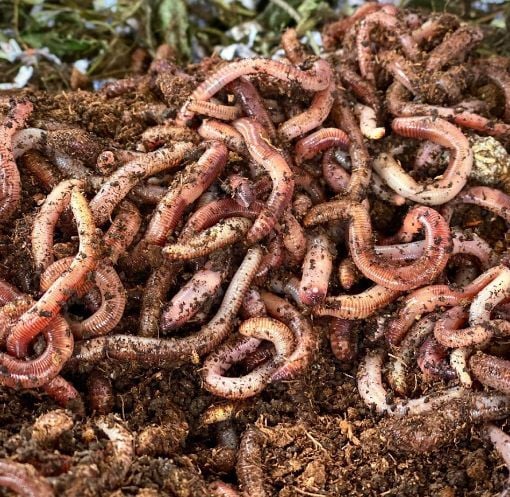 Does it make sense to buy worms and release them into your garden or lawn? When you buy something, you usually keep it. However, European Night Crawlers are a type of worm that stays where the food is. Like free farmhands, these worms will hang around your property and improve the soil. Good soil leads to nutritious vegetables and fruits, blooming flowers, and green lawns. How does a lowly earthworm improve the soil? Why buy worms when wild worms live in the soil? How is releasing worms different from composting in a bin? And how can you encourage the worms to stick around?
Does it make sense to buy worms and release them into your garden or lawn? When you buy something, you usually keep it. However, European Night Crawlers are a type of worm that stays where the food is. Like free farmhands, these worms will hang around your property and improve the soil. Good soil leads to nutritious vegetables and fruits, blooming flowers, and green lawns. How does a lowly earthworm improve the soil? Why buy worms when wild worms live in the soil? How is releasing worms different from composting in a bin? And how can you encourage the worms to stick around?
How Worms Improve the Soil
Worms have been digging into the earth for more than 500 million years. Humans are just 200,000 years old, and we started farming a mere 50,000 years ago. This entire time, earthworms have been breaking down waste organic matter, aerating and fertilizing the soil. They help create soil itself.
When vegetation dies, its nutrients are locked in. The waste organic matter needs to be broken down into usable components such as nitrogen, calcium, phosphorus, etc. Otherwise, new plants could not reuse these nutrients. Microorganisms and fungi get to work, causing the waste vegetation to begin breaking down. Worms then eat the material. In a worm’s gut, the food is digested and mineralized. Valuable soil-friendly bacteria from the worm’s gut hitch a ride. The worms excrete “castings” (worm poop). These castings are a perfect fertilizer for living plants.
Plant roots also need water and air. The worms eat the dirt, digging tunnels. Like tiny plows, earthworms turn the soil and reduce compaction. Digging tunnels aerates the soil — allowing air and water into the ground. Good growing soil has large pores as airspace, and small holes for holding water. Soil that holds water properly give the plants enough moisture, but releases excess moisture. Worm castings are resistant to degradation. They tend to keep their shape, thus contributing to soil aeration. Worms castings appear on top of the soil and in the soil.
As a bonus, worms leave a thin layer of mucus in their tunnels. This part of the soil has more nutrients than surrounding soil.
Adding European Night Crawlers to the Soil
Dig up a shovelful of soil, and you will find worms. The United States has about 100 native species of earthworms, and several alien species have also thrived here. The better the soil is for growing, the more worms you will find.
When you begin cultivating a new patch of land, it may contain earth moved from another location. Worms do not appreciate disruption. They may have died or moved on. The soil may have been treated with chemicals that reduced the worm population. In new construction, the builders may have filled in with subsoil and clay, not topsoil. Most new gardens and lawns can benefit from a fresh dose of European Night Crawlers.
Additionally, gardeners and groundskeepers are always looking for a leg up. Even well-established gardens can see improvement from a few sacks of European Night Crawlers (Super Red). Just order Super Reds from Uncle Jim’s Worm Farm. Healthy soil needs 5 to 10 worms per square foot of surface area. For example, 250 worms will handle 25 to 50 square feet. This rule-of-thumb applies to both gardens and lawns.
Before adding worms to the garden, till the soil and dig in some organic matter. For an established lawn, apply organic fertilizer as a top dressing. Try animal manure, kitchen scraps, mulched leaves, or grass clippings from a chemical-free lawn. This yummy food will be very tempting for the new worms. They will be so busy eating, they will forget about the idea of wiggling away.
To add worms, place them on top of the soil on a dry day and they will dig down. Once they are comfortable, they will reproduce. If conditions remain right, they and their descendants will aerate and fertilize your garden for years to come.
Summary
European Night Crawlers are ideal for releasing into the soil. They process organic waste back into elements that feed plants. They also break up the soil, providing air and water. They are excellent fishing worms. And they can be confined to a composting bin to make concentrated organic fertilizer. You can order them online at Uncle Jim’s Worm Farm.
Note: Their smaller cousins called “Red Worms” are better for composting in a bin.









11 thoughts on “European Night Crawlers: The Power of Worms”
Have Use “Uncle Jim’s” for several Years for Composting in a Bin. Not very good at taking care of them, the worm Bin. I have a Leaf Bin with Shredded leaves that are 20 to 1 with is mostly dust with some whole leaves mixed in. Bin is 6 X 9x 2 . Would 2000 worms be enough?
Thank for Your reply.
Sincerely
Rodney White
What are the ideal temperatures when releasing worms?
If their in your veg garden will they eat them or should I feed them something in there or take them out
Do you have European night crawler in stock, and also the red wigglers
Hello Thomas;
We do have European Night Crawlers in stock and Red Wigglers, however our Red Wigglers are only available in certain counts at this time. Check our site for more information.
Uncle Jim’s Worm Farm
I’ve bought red wiggles to hopefully help with my lawn. It’s a new subdivision & they laid sod on top of the Colorado clay excavation soil! Turf is dry at 2”, but moisture meter shows saturation @3-4”. I did top dress with composted cow manure, but it’s so wet below I don’t know if the worms will burrow. Any suggestions?
Per a gentleman who has written a book on worm bins. Red wigglers do not do well in that environment. Night crawlers would be better. , “How to Start a Worm Bin”
By Henry Owen
Purchased your red wigglers last year for 3 garden areas all with breath of heaven, pittosporum and agave. Followed directions yet never saw any sign of worm life or improvement to garden. Should I go with European night crawlers instead? If yes, would I have to dig in compost material for worms to feed on?
My garden compost pile, kept my red wigglers doing good, through the wintertime, and they weren’t covered up. I have red wigglers, and European night crawlers coming tomorrow from Uncle Jim’s worm farm. That is the best place that I have found to buy worms
very clear and good article easy to understand. Thank you
I’ve ordered 500 of the European night crawlers to use on my lawn. The lawn was in terrible condition, it has a lot of thatch and dead spots from grubs, chinch bugs and no water. If been watering 1.5 inches per week and adding different Jonathan greene micro products to bring the soil back into a reasonable condition. We top dressed last fall and in the spring. Can I just scatter the worms around the yard or do I need to use something like a worm tube to get them going?